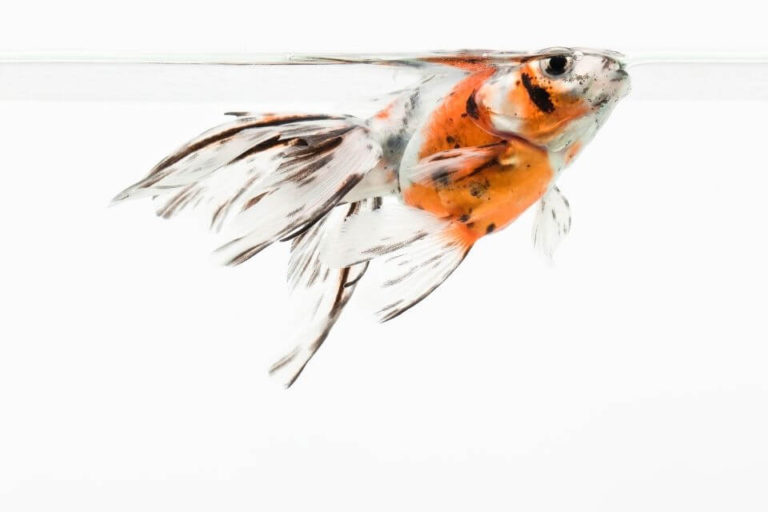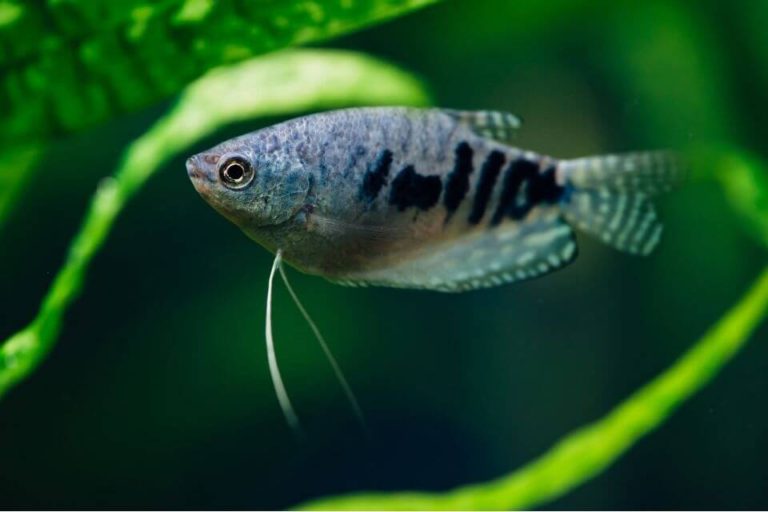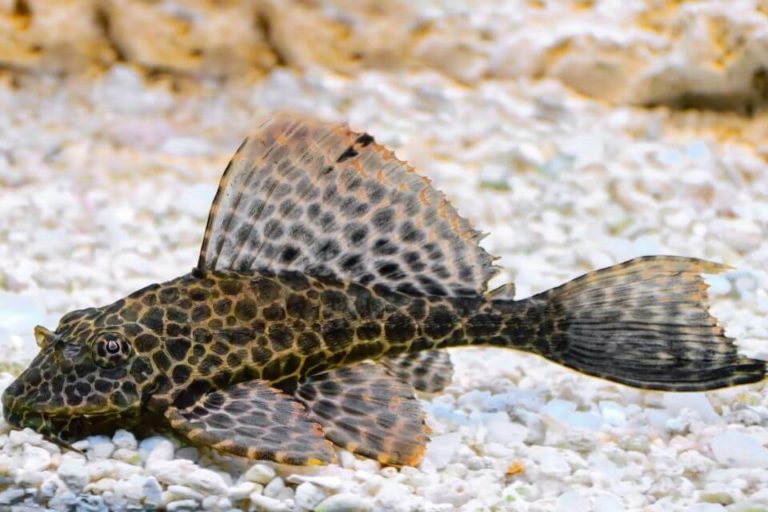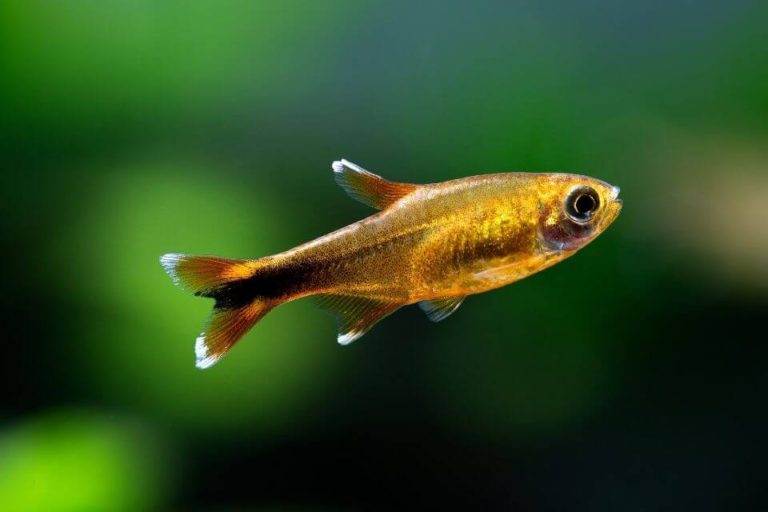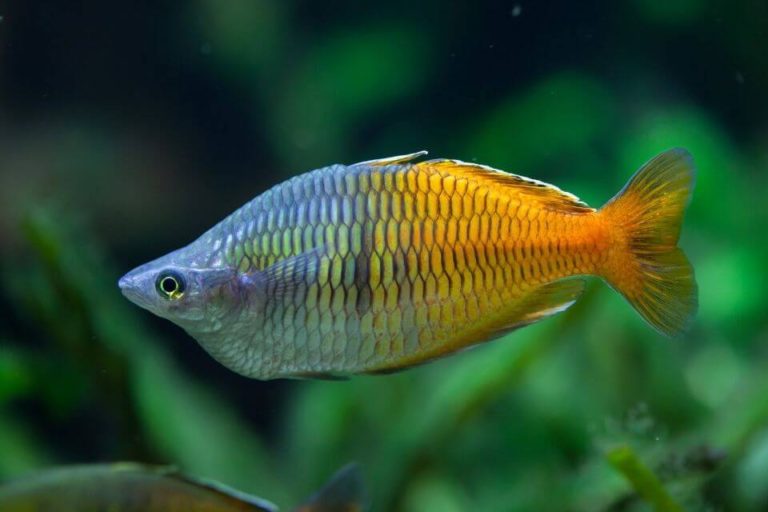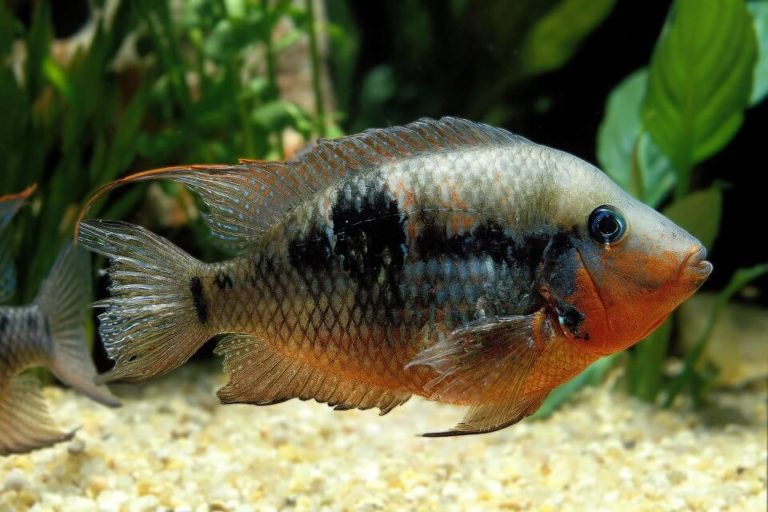Bubble Eye Goldfish Care Guide And Species Profile: Tank Mates and Diet
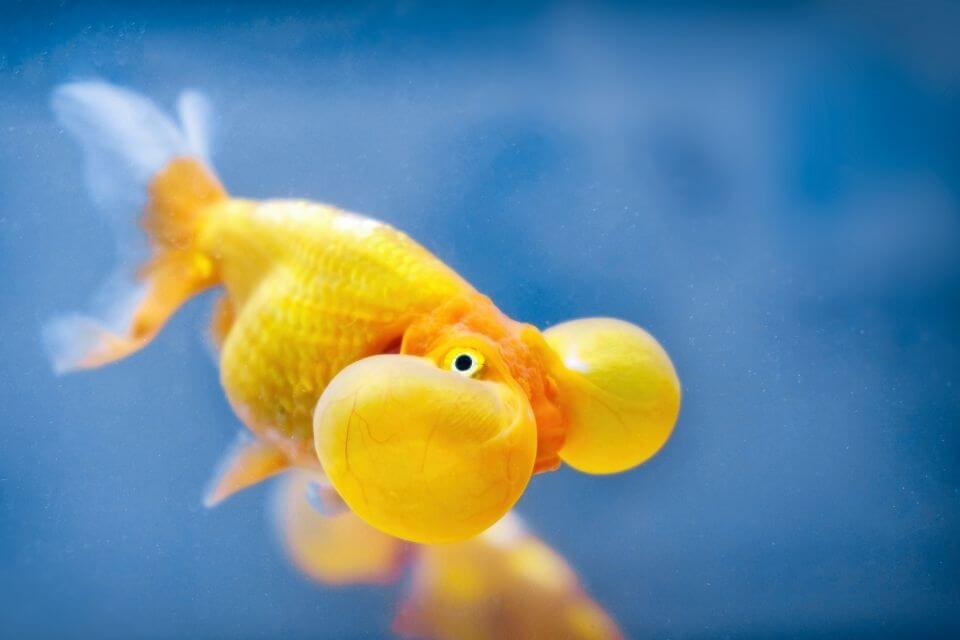
Bubble Eye Goldfish has become a popular pastime among aquarists and professional breeders alike. This pastime has created many new species of fish that people from all over the world want to have in their aquariums.
These Bubble Eye Goldfish is an incredibly unique type of Goldfish with cartoonishly big bubbles around its eyes. They make for a playful pet in most aquariums. They still require some knowledge and care to stay healthy and thriving.
Below, you will find comprehensive care tips from this Bubble Eye Goldfish care guide to help you learn more about the basics of taking care of this Goldfish breed.
| Quick Facts: | |
|---|---|
| Common Names : | Bubble Eye Goldfish |
| Origin : | China |
| Family : | Cyprinidae |
| Scientific Name : | Carassius auratus |
| Care Level : | Moderate |
| Temperament : | Peaceful |
| Social : | Community fish |
| Diet : | Omnivores |
| Size (average) : | 4 inches long |
| Lifespan : | 10 years |
| Breeding : | Egg layer |
| Minimum Tank Size: | 20 gallons |
| Tank Environment : | Freshwater, Sandy substrate or pebbles, Driftwood, Floating Plants |
| Temperature : | 50 – 75 °F (10 – 23 °C) |
| Water Hardness : | 5 - 19 dKH |
| Water pH Level : | 6.5 - 7.5 |
Overview Of Bubble Eye Goldfish
A small and brightly colored freshwater fish, this Goldfish breed has quickly become the most sought-after type of Fancy Goldfish on the market. With a few undeniable features and quirky behaviors, this is a fun and colorful fish to add to any home aquarium.
These Goldfish are exclusively bred in captivity, so you won’t find fish like these in the wild. You will, however, find Bubble Eye Goldfish across several aquariums and freshwater fish stores across the globe.
Since they are bred in captivity, there are a few care concerns that you’ll need to pay attention to. After learning the basics of Fancy Goldfish care, keeping some Bubble Eye Goldfish should be an easy and exciting part of keeping an aquarium.
Bubble Eye Goldfish Lifespan
The Bubble Eye Goldfish lifespan truly depends on the tank conditions and state of care it receives in your aquarium. If your Goldfish is well cared for in a comfortable and safe environment, it can live up to 15 years or more.
Some experienced aquarists even report that they have had this Goldfish breed live up to 20 years. Most of the time, captive-bred Fancy Goldfish like the Bubble Eye will outlive other freshwater fish, especially species that come from the wild.
However, it is truly critical that you consistently provide the best aquarium care and conditions for your Bubble Eye Goldfish lifespan will last for many years.
Bubble Eye Goldfish Size
Bubble Eye Goldfish size is tiny when they are born. They can grow quite quickly as they get older. By the time they are full adults, they can be anywhere from 3 to 5 inches long.
It is hard to tell the difference between male and female Bubble Eye Goldfish as they all reach the same average size.
Bubble Eye Goldfish Behavior
If you are looking for a relaxed and easygoing fish for your tank, this Goldfish breed becomes your favorite. They have some of the best temperaments among freshwater fish species, making them easy to get along with many other species of fish.
They are very peaceful and show no aggression whatsoever against tank mates. These curious fish spend most of the time swimming around the tank, actively searching for food and other places to explore.
You will find them on all layers of the aquarium, from the surface to the substrate. They swim quite slowly, making a beautiful display with their fins and bubble eyes as they go along.
Many people believe their genetic makeup causes them to swim slowly, making them vulnerable to attacks. It is important to keep the Bubble Eye Goldfish in a tank with like-minded, peaceful fish species.
They love to be social with their own kind of fish and as well as other peaceful fish species in their community tank.
Appearance, Colors, and Special Markings
This Goldfish breed has an incredibly unique appearance. Their characteristics make them such a highly sought-after fish in the freshwater aquarium market, with beginner and expert aquarists looking to add a Goldfish or two to their tanks.
While they all have similar colors and characteristics, there are some unique markings that make each Bubble Eye a commodity in the fishkeeping world.
The most obvious trait possessed by the Bubble Eye Goldfish is what gives the fish its name: Large fluid-filled sacs rest just under the eyes and move outward as the fish swims through the water.
The fish has been specifically bred for these eye sacs, and so the larger the sacs, the more valuable the fish. These eye sacs are almost transparent and very delicate.
It is important that this Goldfish is kept in a tank that is free from physical hazards and aggressive fish. Most Bubble Eye Goldfish spot rounded bodies, although some can be thinner.
Some of them have metallic scales, while others have duller yellow colors. They have two beautiful tail fins that flow through the water as they swim.

However, like other Fancy Goldfish, the Bubble Eye has no dorsal fin. This makes it difficult for them to swim, which is another reason why they should be kept in a delicate environment.
You will find this Goldfish breed in dazzling colors of Orange, Yellow, Gold, Black, or Red. Some rare ones even look like miniature Japanese Koi with spots of multiple colors.
Aquarium Care and Conditions
As Bubble Eyes are sensitive fish, they are prone to many vulnerabilities including disease and poor health. An imperative part of keeping Bubble Eye Goldfish healthy and long-lasting is keeping up the best aquarium and tank conditions for this particular type of fish.
Some fishkeepers and homeowners ask whether or not it is okay to keep Bubble Eye Goldfish in ponds. While some people manage to do this, it is generally not recommended.
Because it is harder to control the conditions of pond water. If you are concerned about the best health and support for your fish, you should consider keeping them in a tank with regulated water.
Goldfish have a lot of the same tank preferences as most carp species. As they use most of the tank when they swim around, it is important to invest in the proper substrate, lighting, and decorations for your fish.
– Bubble Eye Goldfish Tank Size
Since the Bubble Eye Goldfish is so small, many fishkeepers believe they do not need a lot of room to thrive. Traditional artwork and media representations always show a single Goldfish in a small bowl-shaped aquarium.
But in reality, they need a little more space than that! Not to mention, it is harder to install water filters and maintain proper tank conditions in a glass bowl.
The minimum tank size you should consider for the Bubble Eye Goldfish is at least 20 gallons. The larger the tank is, the more likely it is that your fish will remain healthy and strong.
If you plan on adding more than one Bubble Eye to your tank – which is highly recommended – you should add at least 5 gallons of tank size per fish.
– Bubble Eye Goldfish Tank Setup
Keep in mind how sensitive the Bubble Eye’s eye sacs are, making sure not to add anything sharp that could damage or harm this part of the fish.
For this reason, the best kind of substrate would be fine sand or pebbles. You could also do well to add a couple of decorations that these fish might want to use as shelter.
You don’t need to go overboard with logs or decorations – just a couple will suffice. Most of the area on the bottom of the tank should be reserved for aquarium plants.
You can use standard lighting and a standard water filter to keep conditions clean and consistent. No additional care is required outside of keeping this tank environment clean.
– Suitable Plants
An abundance of plants in your tank is encouraged. Just take care not to add plants with sharp points, rigid leaves, or other hazardous properties, as they could severely damage your delicate Bubble Eyes.
For the most part, these fish love to use plants as shelter and will even occasionally play with them, uprooting them in the process. Any fish-friendly plant should suffice. You can plant some in the substrate or include floating plants throughout the tank.
A few suggestions include:
- Hornwort
- Marimo Moss Ball
- Bolbitis Fern
- Java Fern
- Anubias
- Anacharis
Be sure to monitor the behavior of your Bubble Eye fish as they interact with the plants. If you feel that the hardy plants are causing a physical hazard for your delicate Goldfish, it might be time to remove them.

– Water Conditions and Parameters
Keeping up with water conditions is the most important part of tank maintenance. Get into the routine of changing out about 25% of the tank’s water every week. Also, make sure your aquarium water filters are in working order.
A further breakdown of the exact parameters needed to care for these fish can be found below:
- Water Temperature: Like most carps, Bubble Eye Goldfish are used to colder waters. Therefore, you do not need a water heater. Be sure to keep the water temperature around 50℉ at all times, with a little bit of flexibility allowed. The warmest temperature the tank should reach is 75℉, but a lower temperature is always preferred.
- Water Acidity: Goldfish need a little bit of acidity in the water to thrive. For this reason, the water should measure between 6.5 and 7.5 pH.
- Water Hardness: When it comes to the hardness levels of the water, you have a bit of wiggle room. Ideal hardness can be anywhere from 5 to 19 dKH at a time. This is a measurement you will want to take fairly often to make sure the correct levels are still being met.
It is important to maintain the water condition stable for the health of your Goldfish. Use aquarium water heater to stabilize the water temperature while keep testing the water conditions using aquarium water testing KIT regularly.
Diet and Feeding
As omnivores, Bubble Eye Goldfish will eat plenty of things. They don’t require the most diverse diet in the world, but keeping their meals rich with proteins and nutrients is a great way to ensure their long life.
If you purchase your Goldfish at the local fish store, you will likely be given a few different options for high-quality fish flakes. It is recommended to get sinking pellets, rather than floating flakes.
This is because Goldfish can consume air when they eat, which is bad for their stomachs. Sinking pellets will eliminate the need for them to venture to the surface.
You don’t have to stop there. You can also supplement their diet with live nutrients and proteins such as:
Bubble Eye Goldfish are active eaters, and they love to explore the tank looking for morsels to eat. Drop some flakes of fruits and vegetables in the tank from time to time to encourage this behavior and to give them a treat.
Most species of freshwater fish can finish their meals in just a few minutes; Bubble Eye Goldfish need a bit longer than that. They struggle to swim and so it may take them some time to float around while they munch on their meals.
Bubble Eye Goldfish Common Diseases
Bubble Eye Goldfish are sensitive creatures, and they are unfortunately susceptible to a number of illnesses and diseases. This is why maintaining proper tank conditions is essential for their health, as you can help them avoid some of the more common ailments.
Along with most freshwater fish, Bubble Eye Goldfish are susceptible to diseases such as:
– Dropsy
Dropsy is defined by a buildup of fluid inside the body. This can happen in the eye sacs or the entire body itself. Dropsy is actually a symptom, rather than its own disease, which can be indicative of bacterial infection. There is a medicine available to treat this symptom.
– Skin Flukes
Skin flukes are an itchy and uncomfortable disease that causes the fish to clamp up, and you will see spots and mucus develop on the front of their body. This can be itchy and painful for the fish, which leads to a quick deterioration of health. You can add an ointment to the water to help them get rid of this disease.
– Swim Bladder Disease
Swim Bladder Disease is a debilitating ailment that causes your fish to float or sink. Your fish may be seen floating on its side with an engorged belly. This can be a very harmful disease if it is not treated right away, which can be done with an ointment and possible isolation.
Gender Differences of Bubble Eye Goldfish
There are not very many gender differences between male and female Bubble Eyes. It can be nearly impossible to sex the fish when they are young. Only when they are ready to breed do some of their differences become evident.
The only noticeable difference between them is that females are usually plumper than males. In addition, males have small bumps or tubercles on their heads, whereas females do not.
Tank Mates for Bubble Eye Goldfish
Despite their peaceful and passive nature, it is not very easy to find the perfect tank mates. They thrive well with members of their own species, but will likely be harmed by any fish that has even the slightest tendency towards aggression.
Not to mention, Bubble Eyes are slow swimmers. A community tank must include fish that are similarly slow and skittish.
Good tankmates include:
- Black Moors
- Telescope Goldfish
- Celestial Goldfish
- Lionhead Goldfish
- Freshwater Snails
Fancy Goldfish species can thrive well together, so they should be your main focus if you are looking to add tank mates to your aquarium.
Bubble Eye Goldfish Breeding
If the perfect conditions are found, Bubble Eye Goldfish will easily breed. They can breed while they remain in large groups, which gets rid of the need to distinguish the gender of your fish.
It is recommended to have a separate breeding tank in order to keep the fry safe. Once the Goldfish lay their eggs separate them from the fries. They will likely try to eat their own eggs.
You can initiate spawning by setting the tank to a temperature of 60℉. Spawned eggs take about a week to hatch, and they can be fed powdered foods until they are a few months old. Within 6 months, they will develop the iconic eye sacs that give them their name.
Origin, Distribution, and Availability
The Bubble Eye Goldfish was bred as a subspecies of Fancy Goldfish that was first appeared in China. While they have existed in Asia for quite some time, they only became popular in other parts of the world after World War II.
While the exact breeding origin of this fish is difficult to trace, it is believed that this Goldfish breed was created as a result of cross-breeding with the Prussian Carp.
They are pretty widely distributed across the entire freshwater aquarium market. It should be easy to find Bubble Eye Goldfish for sale in your local pet store or freshwater fish breeding facilities around you.
Some online aquarium pet sellers might carry Bubble Eye Goldfish for sale which makes it easy for you, but the main problem is the quality of the breed that you are getting from these online stores.
One of the many qualities that make this fish so enjoyable is that they can live a lot longer than most freshwater fish. However, they require a good amount of care in order to reach a healthy old age.
Frequently Asked Questions
What Happens If Bubble Eye Goldfish Popped The Bubble?
You should never try to pop the bubbles of the Bubble Eye Goldfish. If your fish collides with a sharp object or another fish and one of the sacs pops as a result, it could lead to the risk of infection. The sac will expose parts of the body that are more susceptible to bacterial infection and disease.
Depending on the nature of the Bubble Eye Goldfish pop, your fish may end up unharmed. Eventually, the sac will grow scar tissue to seal up the exposed space and protect the fish. In some cases, the broken sac could cause an injured eye and irreversible damage.
Why Do Goldfish Have Bubble Eyes?
Bubble Eye Goldfish were specifically bred to have large bubble-like sacs next to their eyes. This is a desirable physical trait that serves no anatomical purpose other than looking pretty in a goldfish tank. These bubble eyes are made from fluid-filled sacs that flow delicately in the water as the fish swims.
Can Bubble Eye Goldfish Live with Other Goldfish?
Other Goldfish, especially other Fancy Goldfish, are the most ideal tank mates for Bubble Eyes. Due to their peaceful, vulnerable, and skittish dispositions, these fish know how to coexist without causing any trouble. You should definitely consider keeping more than one Bubble Eye together in the same tank as well.
Just remember to keep your tank at a minimum size of 20 gallons and add 5 gallons for each goldfish you introduce to the community.
Why Was the Bubble Eye Goldfish Made?
The Bubble Eye Goldfish was created and cross-bred by fish enthusiasts who wanted to see a fish with big eye sacs. The Bubble Eye was created in China and initially became a popular commodity throughout all of Asia before spreading to the rest of the world.
How Were Bubble Eye Goldfish Made?
Bubble Eye Goldfish were originally bred from mutated crucian carp. It is also rumored to have come from the Prussian carp. Those with the most dramatic eye sacs were selected and bred with each other to create the biggest eye bubbles possible.
The modern breed is one of the most popular types of Fancy Goldfish bred specifically for their aesthetic looks.
Are Black Bubble Eye Goldfish Available?
Yes, of course, you can find Black Bubble Eye Goldfish for sale in the pet market because they have bred in different colors and patterns. But it will little hard to find Black Bubble Eye goldfish because they are not bred commonly as other colorful ones.
Can Bubble Eye Goldfish See?
While Bubble Eye Goldfish can see, they have naturally poor vision due to the fluid-filled sacs next to their eyes. These sacs can obscure their view as they swim, which is another reason why they move so slowly. They may need extra time to locate and eat their food because of this reason.
Are Bubble Eye Goldfish Natural?
Bubble Eye Goldfish are not naturally occurring, and they have never been seen in the wild. They were created as a completely new species by those who crossed different carps together.
The size of their eye sacs would make it impossible for them to survive in dangerous situations or dirty waters, with them becoming so sensitive to disease.

Do Bubble Eye Goldfish Need a Heater?
Bubble Eye Goldfish are used to thrive in relatively cold waters, like most others in their species. You will likely not need to invest in a heater in order to keep your tank’s water at an acceptable temperature.
These fish can live in waters that range from 50℉ to 75℉, and you shouldn’t have a problem maintaining that without a need for additional equipment.
Final Thoughts
The Bubble Eye Goldfish care is surely a lot to take in. Some of its most stunning visual features, like the large eye sacs and elongated tail fins, have been created as a result of years of cross-breeding to find the perfect genetics. In today’s world, thousands of fishkeepers across the globe enjoy looking at Bubble Eye Goldfish in their tanks.
You will find this fish to be fascinating to look at. As long as you can maintain good tank conditions and keep them in a safe environment, they can live for 10 years or more. For all of these reasons and more, the Bubble Eye Goldfish makes a great companion for any fish enthusiast looking to add a peaceful pal to their aquarium.


